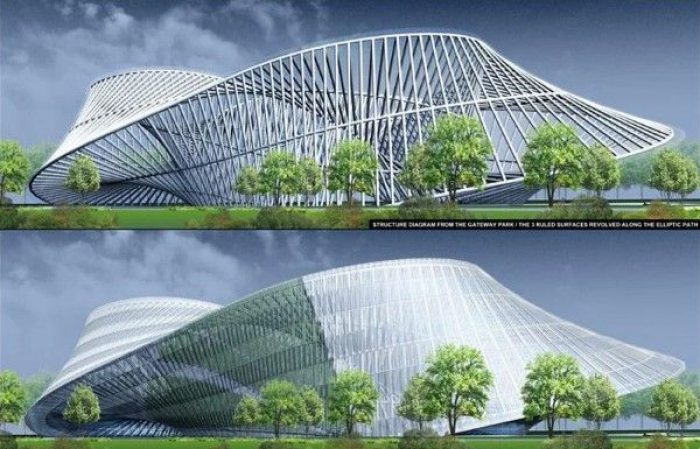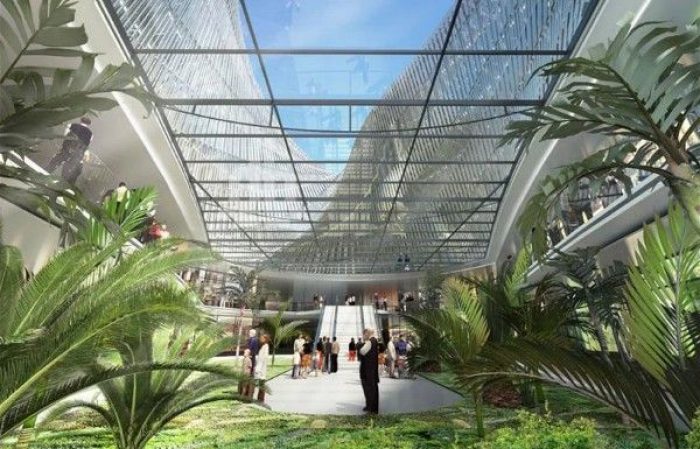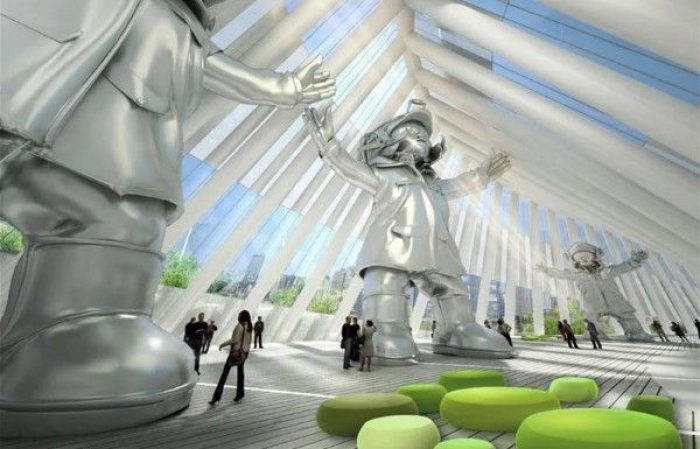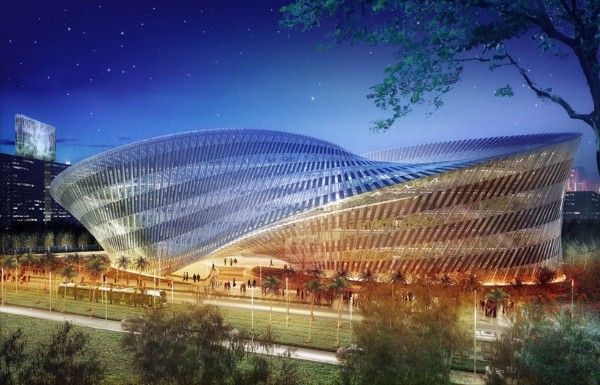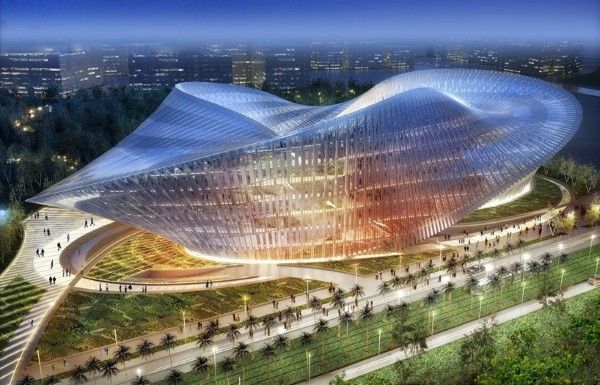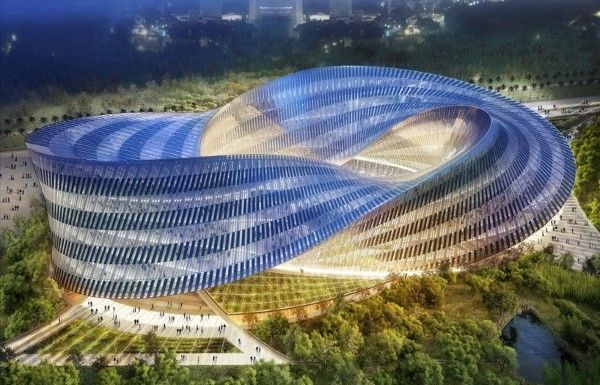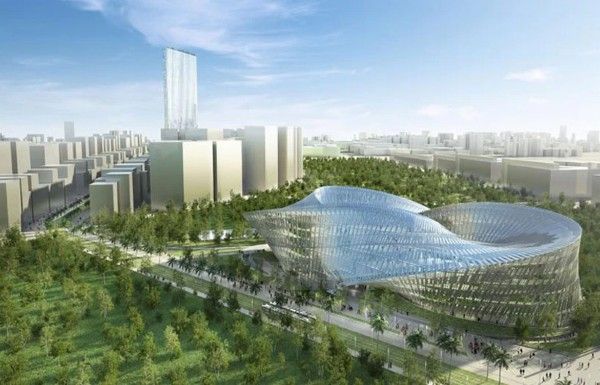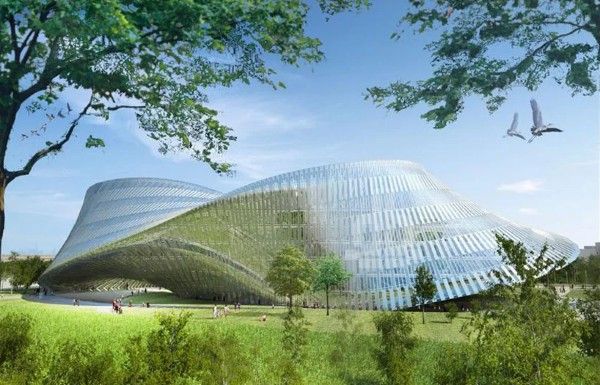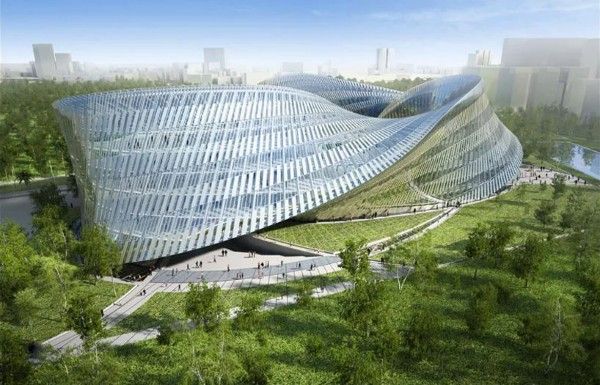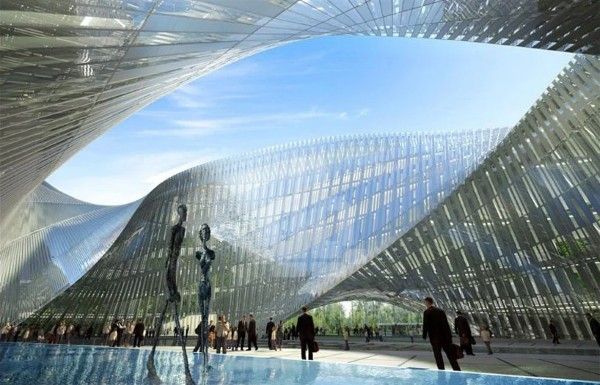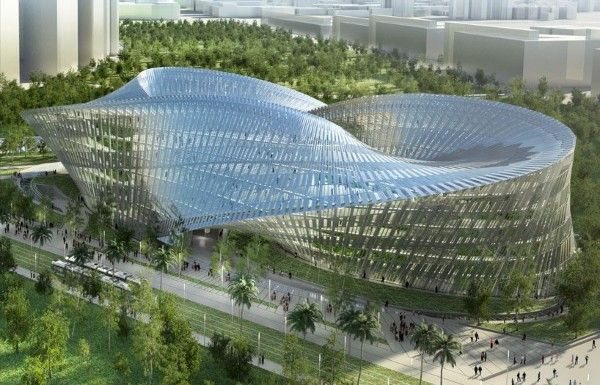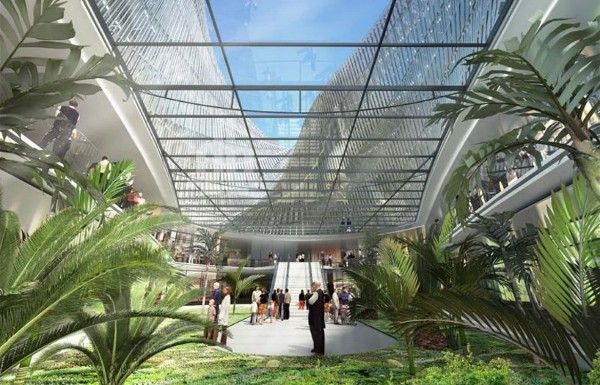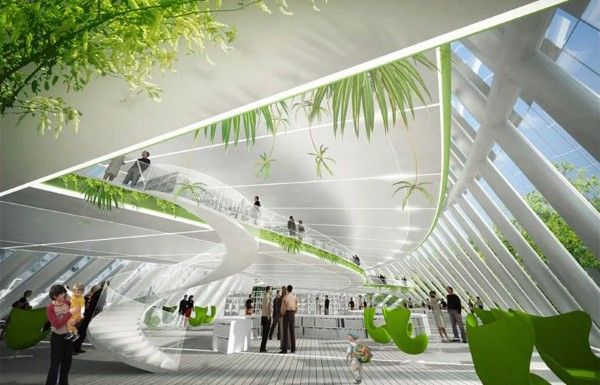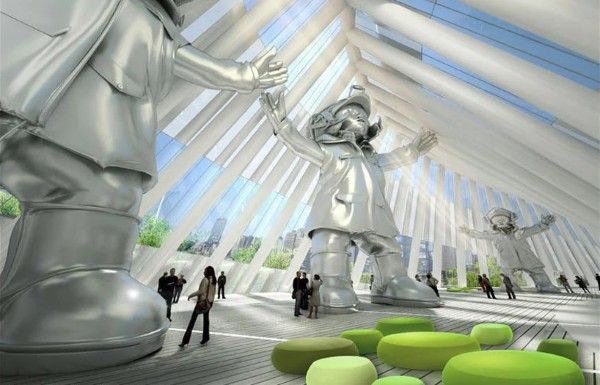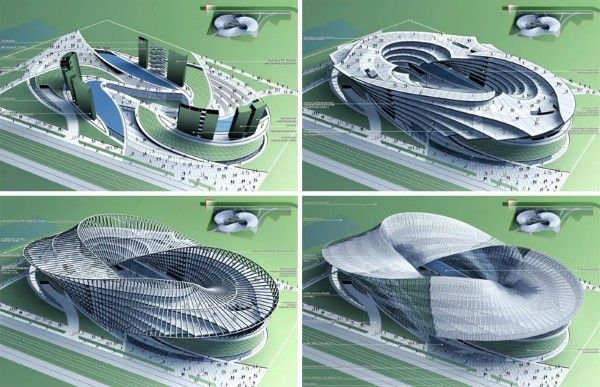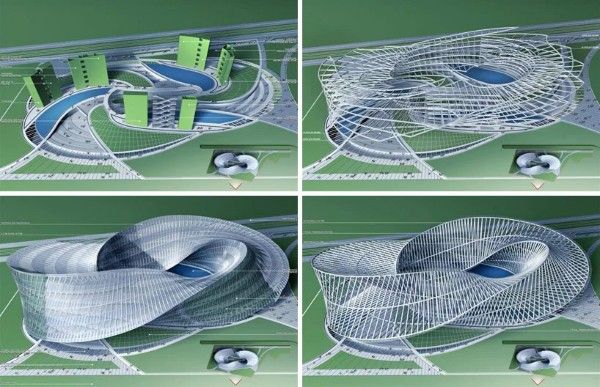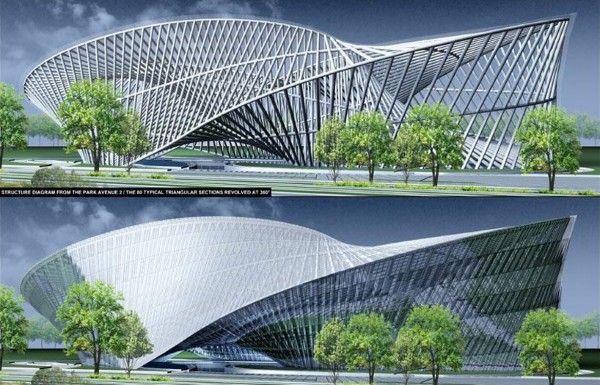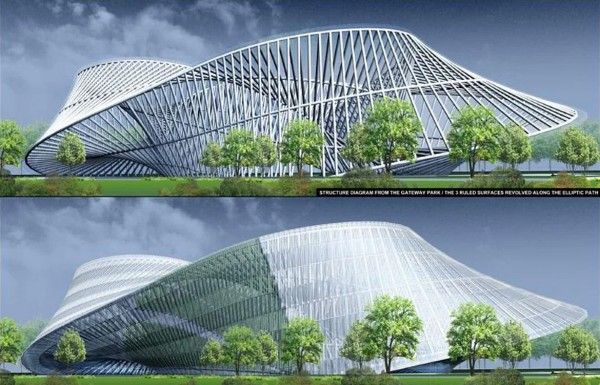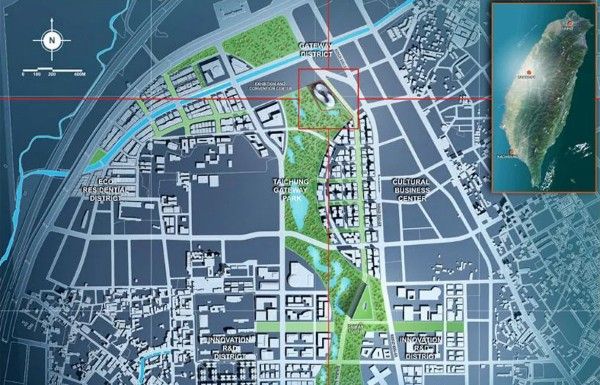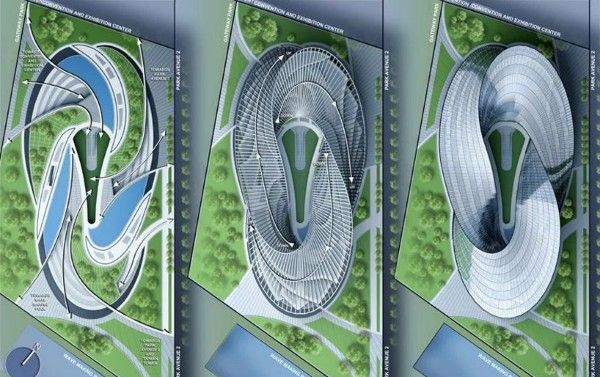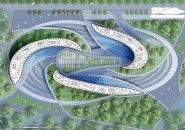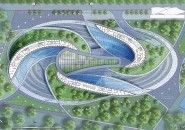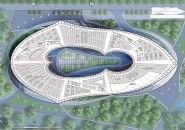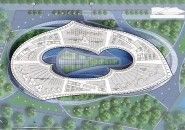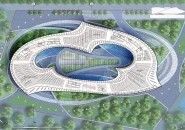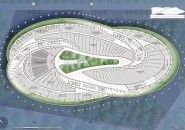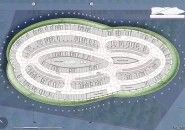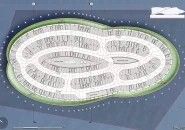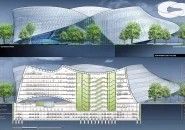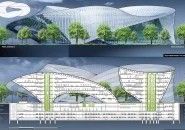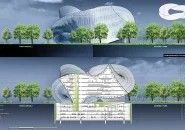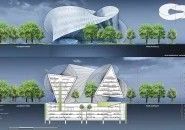French firm, Vincent Callebaut Architectures shared with us its competition entry for Taichung City Cultural Center, Fine Arts Museum & Public Library. The proposal named “Swallow’s Nest” is located at the North end of the new « Gateway Park » on the site of the old airport of Taichung city, the project is a true entrance door to the new urban ecosystem. Actually, the project develops itself under the shape of a three-dimensional Möbius’ ring that extrudes its triangular section around an elliptic path. This organic building is thus created by the simple repetition of a standardised section that turns eighty times clockwise by 4.5 degrees to make a full revolution of 360 degrees around a huge central patio, the “Endless Patio”. The architecture is inspired by the nature and seems to grow harmoniously such as a plant from the earth to the sky. This pure shape in horizontal spiral enables to create three huge vaults, true connexion hubs between the central patio and the cultural centre, the city and the park. The project comes from the natural repartition of the urban flows between the Gateway Avenue 2 (leading to Taiwan Tower in the South of the site), the Convention and Exhibition Centre (in the North) and the Gateway Park (spread from the North to the South). More details from the architect come after the jump.Like a dynamic and innovative cultural center dedicated to the Fine Arts and Literature, the Swallow’s Nest is thus a new icon of spatial transversality and cultural transdisciplinarity! It is a raw diamond cut into the crystal whose sharp voluptuousness magnetizes the site from its spiral curves.
The project components:
Eco-designed from bioclimatic rules, renewable energies and state-of-the-art technologies of Information and Communication, the new cultural center of Taichung city aims at being a pioneer project symbolising the symbiosis of the Nature and Human engineering sciences. Each architectural, structural and technical component is thought to provide a maximum of spatial and functional flexibility aiming at the construction of a building with zero carbon emission.
A box of nature to welcome the public:
Möbius’ ring is based on 1000m² of groundfloor spread out on three great pilasters on which the three vaults set up with strength. This structural concept enables to liberate completely the ground by transforming it into a huge aquatic and floral garden. This open landscape multiplies the visual perspectives towards the Gateway Park and constitutes an permeable architecture to the flows which cross it. In order to limit the visual impact of the building volume, the Swallow’s Nest takes root into the ground by three great spiral banisters that extend the mineral or planted public spaces towards the main big reception hall of the center located underground at basement one. This creates a wide central agora where all the functions of reception of the public, tickets offices, shops and cafeterias centre around under a huge canopy in pretended steel structure and e-low glass. This canopy shrouds the space with a natural zenithal light. The hall gives also access to the convention center, to the educative workshops and to the archives of the cultural center.
A peripheral seismic joint to be protected from earthquakes
To assure the protection of the building in case of earthquake, the base of the building sets up on earthquake-resistant supports which are located under the last parking level of the isolator floor. The horizontal movements of the centre are isolated from the earth by a seismic joint that surrounds all the perimeter of the basement levels. A moat is thus created between the floor edges and the slurry wall. This is covered by planted walls and becomes a peripheral light well that enables to ventilate and light up naturally the logistic functions of the museum and the library, of the scooters and cars park. The fire escapes are integrated along the slurry wall and lead to the open-air ground floor. Finally to protect this moat from typhoon, a glass canopy overhangs it by assuring thus the tightness of the earthquake-resistant system.
A parametric structure divided into three ruled surfaces
The strength of the concept resides in the genesis of a complex geometry for the steel structure from the repetition of standard and simple elements. Actually, the typical section in the shape of an isosceles triangle is made with three great tubular beams forming an arch. The 80 arches are linked together at their centre and their ends by mega-columns which form the main edge and spread the loads to the ground. The twist at 360 degrees of the three faces of the triangle is designed under the shape of three ruled surfaces easily adjusted and decomposable into flat panels for a more pragmatic feasibility and a better cost control.
 A spatial hyper-flexibility provided by alveolar double decks
A spatial hyper-flexibility provided by alveolar double decks
The eight floor levels draw arabesques along the three-dimensional ribbon by ramifying the tubular structure. The whole forms a functional thick pile where each museum gallery or reading space is double oriented either towards the Endless Patio or toward the city. The plans are dynamic and generate a multiplicity of spatial typologies with variable height in simplex, duplex, triplex. The flexibility is obtained by a double-decks system that pinches a radiant alveolar beam network. This network of perforated beams enables to integrate all the flows of canalisation, air conditioning, electricity and optical fibres in order to enable an infinite transferability of each space and assuring everywhere an optimal ceiling height.
Three Tree towers to distribute the vertical flows
The floors are crossed by three cores entirely planted by living walls that create three vertical gardens welcoming visitors from the central agora as well as MEP flows of inputs and outputs. To highlight these true spatial landmarks, they are separated from the slabs by hollow joints covered by glass enabling thus to see the cores, from the ground floor to the solar roof, by transparency on their whole height. Finally, a snake of escalators and panoramic elevators in structural glass enable to take advantage of the green landscape of the Gateway Park and to create thus an hyper outside-inside connectivity. Between these tree towers purifying and cooling down the interior atmosphere by evapotranspiration of plants, the functions are organised in open spaces interlaced by themes between the Arts, the Literature, the Sciences and the Foreign Languages for the library for example, or between the permanent and temporary exhibitions for the museum.
Intelligent façades of e-low glass pixelated by the photovoltaic solar cells assuring an energetic autonomy
The Swallow’s Nest is the future landmark of the Gateway Park. The project is thus crystalline assuring a maximum of transparency and lighting effects by the treatment of façades, from the integration of renewable energies, intelligent glasses and effects of progressive translucency. Actually, the glittering skin is made of E-Low glass with high rate of thermal isolation. Like a musical score opening out along the glass ribbons, pixels of photovoltaic solar cells and panels of translucent glass and stainless steel assure 50% of opaque façades in order to avoid greenhouse effect on the one hand and to protect the exhibited works on the other hand.
A POETIC GREEN LANDMARK
From the Endless Patio, the Gateway Park or the Gateway Park Avenue 2, the facades create mirror effects by reflecting the rustles and the vibrations of the city and of the surrounding nature. These façades question us by transforming themselves in mirror of our society and act as a spectre for the creation of the contemporary art and for the protection of the knowledge. At daytime, the adjusted surfaces of the façades degrade the azure blue towards the tender greens of the luxuriant vegetation of the park. Whereas during the night, the Klein blue of the stars reverses progressively to gold colour of the dawn and the lights of the urban lighting.
The new centre of Taichung has been transformed into a nest of preservation and cultural creation that sees the birth of history in real time, the sensitivities and the Taiwanese philosophies mixed worldwide. In this sustainable architecture dedicated to the biodiversity and the right balance of the action of Human being on Nature, the museum intertwines in the library, the plant embraces the mineral, and the shadow mixes up with the light. The swallow’s nest is a glittering landmark which expresses with elegance the swirling of the imagination. Like the Möbius’ ring, it is a cultural centre without end which will constantly question, intrigue and attract the attention of its visitors.
courtesy of vincent callebaut architectures
courtesy of vincent callebaut architectures
courtesy of vincent callebaut architectures
courtesy of vincent callebaut architectures
courtesy of vincent callebaut architectures
courtesy of vincent callebaut architectures
courtesy of vincent callebaut architectures
courtesy of vincent callebaut architectures
courtesy of vincent callebaut architectures
courtesy of vincent callebaut architectures
courtesy of vincent callebaut architectures
courtesy of vincent callebaut architectures
courtesy of vincent callebaut architectures
courtesy of vincent callebaut architectures
structural diagram from park avenue
structural diagram from the gateway park
site plan of shui nan ecological gateway district of taichung city
roof plan
courtesy of vincent callebaut architecturescourtesy of vincent callebaut architectures
courtesy of vincent callebaut architectures
courtesy of vincent callebaut architectures
courtesy of vincent callebaut architectures
courtesy of vincent callebaut architectures
courtesy of vincent callebaut architectures
courtesy of vincent callebaut architectures
courtesy of vincent callebaut architectures
courtesy of vincent callebaut architectures
courtesy of vincent callebaut architectures
courtesy of vincent callebaut architectures
courtesy of vincent callebaut architectures
courtesy of vincent callebaut architectures


